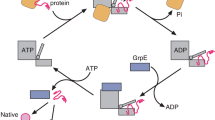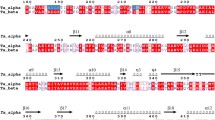Abstract
Refolding of firefly Photinus pyralis luciferase from a denatured state is a slow process; its rate and productivity depend on molecular chaperones of the Hsp70 family. In contrast, cotranslational folding of luciferase is fast and productive in the absence of chaperones. During cotranslational folding, the C termini of polypeptides are associated with ribosomes, massive particles. The question arises as to whether C-terminal immobilization on a massive particle promotes folding. To study this problem experimentally, luciferase was C-tagged with hexahistidine to allow its C-terminal immobilization of chelating Sepharose. Both immobilized and free chains of the urea-denatured enzyme refolded at the same rate. At the same time, immobilization led to a higher refolding yield owing to the prevention of intermolecular aggregation. Chaperones of the Hsp70 family promoted folding of both immobilized and free luciferase polypeptides. It was assumed that the high rate of cotranslational folding is not ensured by mere immobilization of the C terminus of the polypeptide, but is rather due to a favorable start conformation of the growing peptide in the peptidyltransferase center of the ribosome and/or the vectorial character of the folding, proceeding from the N to the C end during polypeptide synthesis.
Similar content being viewed by others
References
Conti E., Francs N.P., Brick P. 1996. Crystal structure of firefly luciferase throws light on a superfamily of adenylate-forming enzymes. Structure. 4, 287–298.
Kolb V.A., Makeyev E.V., Spirin A.S. 1994. Folding of firefly luciferase during translation in a cell-free system. EMBO J. 13, 3631–3637.
Kolb V.A., Makeyev E.V., Spirin A.S. 2000. Co-translational folding of an eukaryotic multidomain protein in a prokaryotic translation system. J. Biol. Chem. 275, 16,597–16,601.
Frydman J., Nimmesgern E., Ohtsuka K., Hartl F.U. 1994. Folding of nascent polypeptide chains in a high molecular mass assembly with molecular chaperones. Nature. 370, 111–117.
Svetlov M.S., Kommer A., Kolb V.A., Spirin A.S. 2006. Effective cotranslational folding of firefly luciferase without chaperones of Hsp70 family. Protein Sci. 15, 242–247.
Herbst R., Schafer U., Seckler R. 1997. Equilibrium intermediates in the reversible unfolding of firefly (Photinus pyralis) luciferase. J. Biol. Chem. 272, 7099–7105.
Zako T., Deguchi H., Kitayama A., Ueda H., Nagamune T. 2000. Refolding of firefly luciferase immobilized on agarose beads. J. Biochem. (Tokyo). 127, 351–354.
Schroder H., Langer T., Hartl F.-U., Bukau B. 1993. DnaK, DnaJ and GrpE form a cellular chaperone machinery capable of repairing heat-induced protein damage. EMBO J. 12, 4137–4144.
Szabo A., Langer T., Schroder H., Flanagan J., Bukau B., Hartl F.U. 1994. The ATP hydrolysis-dependent reaction cycle of the Escherichia coli Hsp70 system: DnaK, Dnal, and GrpE. Proc. Natl. Acad. Sci. USA. 91, 10,345–10,349.
Buchberger A., Schroder H., Hesterkamp T., Schonfeld H.-J., Bukau B. 1996. Substrate shuttling between the DnaK and GroEL systems indicates a chaperone network promoting protein folding. J. Mol. Biol. 261, 328–333.
Schagger H., von Jagow G. 1987. Tricine-sodium dodecyl sulfate-polyacrylamide gel electrophoresis for the separation of proteins in the range from 1 to 100 kDa. Anal. Biochem. 166, 368–379.
Hochuli E., Dobeli H., Schacher A. 1987. New metal chelate absorbent selective for proteins and peptides containing neighbouring histidine residues. J. Chromatogr. 411, 177–184.
Stempfer G., Holl-Neugebauer B., Rudolph R. 1996. Improved refolding of an immobilized fusion protein. Nature Biotechnol. 14, 329–334.
Fedorov A.N., Baldwin T.O. 1997. Cotranslational protein folding. J. Biol. Chem. 272, 32,715–32,718.
Spirin A.S. 1984. Cotranslational folding, compartmentalization, and modification of proteins. Mol. Biol. 18, 1445–1460.
Wright P.E., Dyson H.J., Lerner R.A. 1988. Conformation of peptide fragments of proteins in aqueous solution: Implications for initiation of protein folding. Biochemistry. 27, 7167–7175.
Teale J.M., Benjamin D.C. 1977. Antibody as immunological probe for studying refolding of bovine serum albumin. Refolding within each domain. J. Biol. Chem. 252, 4521–4526.
Phillips D.C. 1967. The hen egg-white lysozyme molecule. Proc. Natl. Acad. Sci. USA. 57, 484–495.
Lim V.I., Spirin A.S. 1999. Stereochemical analysis of ribosomal transpeptidation. Conformation of nascent peptide. J. Mol. Biol. 188, 565–574.
Author information
Authors and Affiliations
Additional information
Original Russian Text © M.S. Svetlov, V.A. Kolb, A.S. Spirin, 2007, published in Molekulyarnaya Biologiya, 2007, Vol. 41, No. 1, pp. 96–102.
Rights and permissions
About this article
Cite this article
Svetlov, M.S., Kolb, V.A. & Spirin, A.S. Folding of the firefly luciferase polypeptide chain with the immobilized C terminus. Mol Biol 41, 86–92 (2007). https://doi.org/10.1134/S0026893307010128
Received:
Accepted:
Issue Date:
DOI: https://doi.org/10.1134/S0026893307010128




